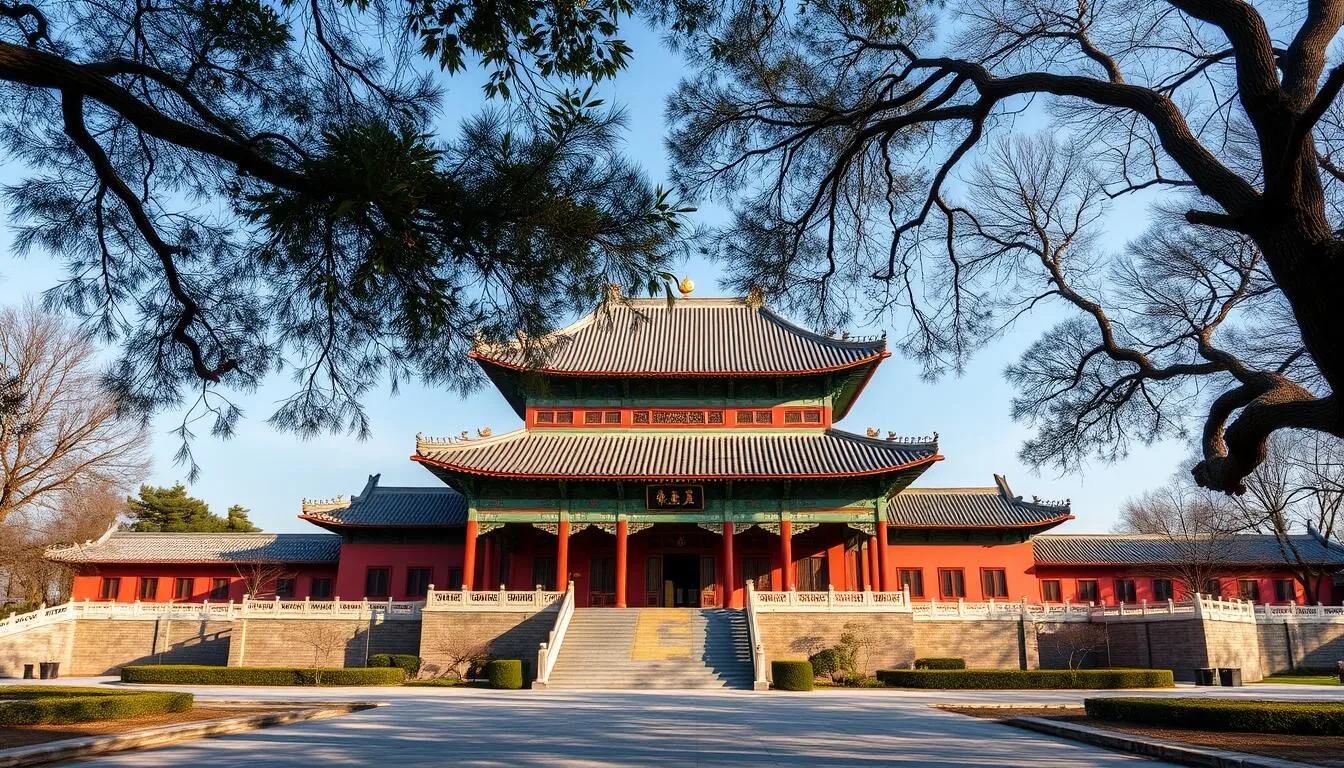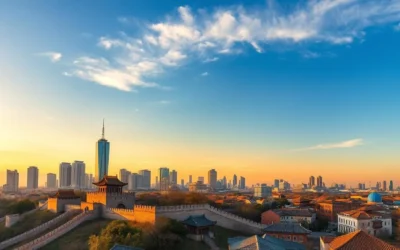✓ Accommodations ✓ Flights ✓ Rental Cars ✓ Tours & Activities
China’s largest urban area; global finance hub and Yangtze estuary port.
2. Beijing – ~21,893,095
Capital city and national political & cultural centre.
3. Guangzhou – ~18,810,600
Major Pearl River Delta port city with global commerce significance.
4. Chengdu – ~16,935,567
Sichuan capital; booming western tech, finance and innovation centre.
5. Chongqing – ~16,875,000
Municipality city‑proper; significant inland administrative megacity.
6. Shenzhen – ~14,678,000
Iconic SEZ next to Hong Kong; global technology and manufacturing hub.
7. Tianjin – ~13,866,009
Coastal industrial municipality near Beijing with major port facilities.
8. Wuhan – ~12,326,500
Yangtze River transport and education centre in central China.
9. Xi’an – ~11,904,805
Historic city and Silk Road hub; home of the Terracotta Army.
10. Hangzhou – ~10,711,238
Zhejiang capital; known for scenic West Lake and digital economy (Alibaba).
11. Dongguan – ~10,466,625
Key Pearl River Delta manufacturing hub in Guangdong province.
12. Foshan – ~9,498,863
Ceramics and light‑industry centre adjacent to Guangzhou.
13. Nanjing – ~9,314,685
Jiangsu capital with historic legacy and strategic Yangtze port location.
14. Jinan – ~8,352,574
Shandong capital; renowned for springs and regional administration.
15. Shenyang – ~7,885,142
Liaoning capital; traditional northeast industrial and education centre.
16. Qingdao – ~7,172,451
Shandong coast city; famous for Tsingtao beer and German colonial architecture.
17. Harbin – ~6,976,136
Heilongjiang capital known for ice festival and Russian‑influenced downtown.
18. Zhengzhou – ~6,650,532
Henan capital; major rail & logistics node in central China.
19. Changsha – ~5,980,707
Hunan capital; rising media, innovation and cuisine‑focused city.
20. Kunming – ~5,950,578
Yunnan capital; high‑altitude gateway to Southeast Asia.
21. Dalian – ~5,736,383
Liaoning port city with strong industry, finance, and coastal tourism.
22. Changchun – ~5,691,024
Jilin capital; major centre for automotive manufacturing and rail tech.
23. Xiamen – ~5,163,970
Fujian SEZ known for its island beauty, port economy, and Taiwanese ties.
24. Ningbo – ~5,057,140
Zhejiang port city; historical commerce hub and modern shipping leader.
25. Hefei – ~5,055,978
Anhui capital with growing innovation and education sectors.
26. Shijiazhuang – ~5,090,440
Hebei capital; transportation crossroads southwest of Beijing.
27. Nanchang – ~5,630,256
Jiangxi capital; revolutionary history and rising industrial activity.
28. Daqing – ~4,571,259
Heilongjiang city built around China’s largest oilfield.
29. Taiyuan – ~4,529,141
Shanxi capital; transitioning from coal base to diversified industry.
30. Zhongshan – ~4,418,060
Guangdong manufacturing city named after Sun Yat-sen.
31. Ürümqi – ~4,335,017
Xinjiang capital; multicultural gateway city on the ancient Silk Road.
32. Suzhou – ~4,330,000
Jiangsu city famed for canals, gardens, and high-tech economy.
33. Shantou – ~4,312,192
Coastal SEZ in Guangdong; legacy of overseas Chinese commerce.
34. Fuzhou – ~4,094,491
Fujian capital with growing high-tech and maritime economy.
35. Nanning – ~3,839,800
Guangxi capital; China-ASEAN Expo host and ethnic diversity hub.
36. Wenzhou – ~3,604,446
Entrepreneurial Zhejiang city known for private business networks.
37. Changzhou – ~3,601,079
Jiangsu city in Yangtze Delta; manufacturing and innovation park cluster.
38. Xuzhou – ~3,549,622
Northern Jiangsu city; historical crossroads and growing logistics base.
39. Guiyang – ~3,483,100
Guizhou capital; fast-growing digital and data services hub.
40. Tangshan – ~3,399,231
Hebei steel city reborn after 1976 earthquake with strong industry.
41. Wuxi – ~3,256,000
Lakeside city in Jiangsu; strong in light industry, tourism, and innovation zones.
42. Lanzhou – ~3,072,100
Gansu capital on the Yellow River; former Silk Road trading post.
43. Baotou – ~2,872,000
Inner Mongolia city known for rare earth mining and steel industry.
44. Yantai – ~2,868,000
Shandong coastal city; fishing, wine, and international trade.
45. Quanzhou – ~2,810,000
Historic Fujian port; maritime Silk Road heritage and manufacturing hub.
46. Jilin – ~2,703,000
Northeast city along Songhua River; chemicals and car manufacturing.
47. Zhuhai – ~2,681,000
SEZ in Guangdong; coastal city across from Macau with tourism and tech.
48. Zibo – ~2,635,000
Shandong industrial city with ceramic, pharmaceutical, and petrochemical sectors.
49. Huizhou – ~2,628,000
Guangdong city with electronics, green tech, and historic sites.
50. Baoding – ~2,612,000
Hebei city; logistics and growing manufacturing base near Beijing.
51. Xining – ~2,563,000
Capital of Qinghai; ethnic diversity and gateway to Tibetan Plateau.
52. Weifang – ~2,559,000
Known for kites and manufacturing in central Shandong.
53. Zaozhuang – ~2,546,000
Shandong city with coal mining heritage and modern industry.
54. Yinchuan – ~2,544,000
Capital of Ningxia; Hui cultural centre and Yellow River irrigation base.
55. Nantong – ~2,517,000
Yangtze River port city in Jiangsu; textile and marine economy.
56. Handan – ~2,507,000
Hebei city with deep historical roots and industrial growth.
57. Anyang – ~2,504,000
Henan city; site of ancient Chinese capitals and bronze culture.
58. Liuzhou – ~2,496,000
Guangxi city on the Liu River; known for auto and machinery industries.
59. Luoyang – ~2,474,000
Historic city in Henan; ancient capital and Buddhist Longmen Grottoes.
60. Hengyang – ~2,470,000
Hunan’s second largest city; rail junction and industrial base.
61. Zhenjiang – ~2,467,000
Yangtze River city in Jiangsu; ancient capital with strong port activity.
62. Shaoxing – ~2,465,000
Historic Zhejiang city known for rice wine, scholars, and textile production.
63. Tangshan – ~2,464,000
Hebei steel city rebuilt after 1976 earthquake; major industrial center.
64. Jining – ~2,461,000
Shandong city; Confucius’ hometown area with coal and machinery industries.
65. Hohhot – ~2,461,000
Capital of Inner Mongolia; political and economic hub of the autonomous region.
66. Anshan – ~2,426,000
Liaoning city; center for China’s steel production and mineral resources.
67. Linyi – ~2,395,000
Large Shandong city; logistics hub with traditional markets and handicrafts.
68. Changde – ~2,395,000
Hunan city; rice, citrus and chemical manufacturing base in the north of province.
69. Jinhua – ~2,383,000
Zhejiang inland city; industrial base and key rail intersection.
70. Zhangjiakou – ~2,382,000
Hebei mountain city; co-host of 2022 Winter Olympics and clean energy hub.
71. Jinzhou – ~2,365,000
Liaoning city; light industry and shipping center on the Bohai Sea.
72. Zhanjiang – ~2,350,000
Southern Guangdong port city; seafood and petrochemical industries.
73. Shaoyang – ~2,349,000
Western Hunan city with growing textiles, electronics and agriculture base.
74. Jiaxing – ~2,337,000
Zhejiang city between Shanghai and Hangzhou; strong in electronics and trade.
75. Yueyang – ~2,323,000
Hunan city on Dongting Lake; transportation hub and paper manufacturing.
76. Taizhou (Jiangsu) – ~2,317,000
Manufacturing and pharmaceutical center in central Jiangsu province.
77. Xingtai – ~2,316,000
Southern Hebei city; one of China’s oldest continuously inhabited cities.
78. Zhumadian – ~2,312,000
Henan city; agriculture and light industry on major rail lines.
79. Yancheng – ~2,302,000
Jiangsu city near Yellow Sea; salt, chemicals and wind energy industries.
80. Chaozhou – ~2,296,000
Eastern Guangdong city known for traditional culture and porcelain.
81. Hengshui – ~2,293,000
Hebei city with traditional culture and growing manufacturing economy.
82. Puyang – ~2,284,000
Northeastern Henan city; known for petrochemicals and agriculture.
83. Meizhou – ~2,282,000
Eastern Guangdong city; Hakka cultural center with strong tea and tourism industries.
84. Baicheng – ~2,280,000
Jilin city on western grasslands; developing wind energy and agriculture.
85. Suqian – ~2,278,000
Northern Jiangsu city; newer urban zone with food processing and textiles.
86. Binzhou – ~2,276,000
Shandong city in Yellow River Delta; oil, salt, and cotton economy.
87. Leshan – ~2,273,000
Sichuan city known for the Giant Buddha and tourism along the Min River.
88. Heze – ~2,270,000
Southwest Shandong city; renowned for peonies and agricultural trade.
89. Ma’anshan – ~2,260,000
Anhui city on the Yangtze; steel manufacturing and green development.
90. Suining – ~2,246,000
Central Sichuan city; logistics, agriculture and renewable energy hub.
91. Guilin – ~2,242,000
Guangxi city famed for dramatic karst landscapes and tourism.
92. Langfang – ~2,238,000
Hebei city between Beijing and Tianjin; part of integrated economic zone.
93. Nanyang – ~2,237,000
Henan city with ancient history and strong agriculture base.
94. Fushun – ~2,229,000
Liaoning city; historically coal-based, now diversifying economy.
95. Tianshui – ~2,222,000
Gansu city; Silk Road heritage and agriculture/industry center.
96. Yangzhou – ~2,221,000
Historic Jiangsu canal city with cultural tourism and light manufacturing.
97. Jinzhong – ~2,215,000
Shanxi city; rising urban-industrial area near provincial capital Taiyuan.
98. Qiqihar – ~2,214,000
Heilongjiang city; rail hub and traditional Manchu cultural center.
99. Jieyang – ~2,211,000
Eastern Guangdong city with a growing electronics and metals economy.
100. Shaoguan – ~2,209,000
Mountainous Guangdong city with eco-tourism and traditional industries.
101. Pingdingshan – ~2,202,000
Henan city with strong coal industry and power generation base.
102. Liaoyang – ~2,200,000
Liaoning city; historic and industrial area in northeast China.
103. Huzhou – ~2,198,000
Zhejiang city; eco-friendly industries and scenic lake surroundings.
104. Yibin – ~2,192,000
Southern Sichuan city at confluence of rivers; known for Wuliangye liquor.
105. Neijiang – ~2,191,000
Sichuan city with sugar processing and mechanical manufacturing sectors.
106. Chifeng – ~2,178,000
Inner Mongolia city; mining, agriculture, and ethnic diversity.
107. Lu’an – ~2,162,000
Western Anhui city with green tea cultivation and emerging industries.
108. Yangquan – ~2,147,000
Shanxi city; traditionally based on coal mining and metallurgy.
109. Panjin – ~2,141,000
Liaoning city near the Liao River Delta; famous for Red Beach wetlands.
110. Deyang – ~2,128,000
Sichuan industrial city; machinery and equipment manufacturing hub.
111. Bengbu – ~2,115,000
Anhui city on the Huai River; food processing and glass industries.
112. Shiyan – ~2,108,000
Hubei city; home to Dongfeng Motor Corporation and scenic Wudang Mountains.
113. Xianyang – ~2,104,000
Shaanxi city; historical Qin dynasty capital near Xi’an with electronics and aerospace industries.
The above is subject to change.
Check back often to TRAVEL.COM for the latest travel tips and deals.






